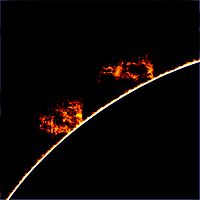Student X's Portfolio

Personal
Solar Prominences
In this example, all components related to a task are posted on a single web page with links to documents, rubrics, etc.
In this task we use a solar telescope at the school observatory to find solar prominences. We also have to draw what we see to train our eyes to look for details. Finally, we have to do some research on the web and write up a page about our findings and reflections. The paper will be graded using this rubric.
The main goal is to understand solar prominences. Mr. Johnson wants us to also learn about telescopes and their differences, viewing hazards, and being able to report what we see.

Research (taken from wikipedia.org. After all, this is a fictitious Portfolio)

A solar prominence is a large bright feature extending outwards from the sun's surface, often in a loop configuration. Prominences are anchored to the solar surface in the photosphere, and extend outwards into the solar corona. While the corona consists of extremely hot ionized gases, known as plasma, which do not emit much visible light, prominences contain much cooler plasma, similar in composition to that of the chromosphere. A prominence forms over timescales of about a day, and stable prominences may persist in the corona for several months. Some prominences break apart and give rise to coronal mass ejections.
Despite decades of study, the mechanism by which prominences form is not yet well understood. Theories have not satisfactorily explained how prominences can remain stable for such a long time when they are much denser than their surroundings. Magnetic fields are known to be the dominant influence on gas motions within the corona, but the exact form of magnetic interaction required to produce and maintain a large prominence has yet to be determined.
A typical prominence extends over many thousands of kilometres; the largest observed by SOHO was seen in 1997 and was some 350,000 km (216,000 miles) long [1] - some 28 times the diameter of the Earth. The mass contained within a prominence is typically of the order of 100 billion tonnes of material.
If a solar prominence occurs on the disc of the sun it appears darker than its background (due to the lower temperature of the plasma). These are referred to as solar filaments.
Well, not really my drawing because I don't exist. Credits should be given to http://www.runarsandnes.com/astro/sun210406.jpg where I grabbed this picture.
I learned a few very interesting things from this task. First of all, the sun looks absolutely awesome in a solar telescope. I learned not look at the sun through a regular telescope. It can burn the retina in my eye and permenantly blind me. What I really liked about this task was to learn about the size of solar prominences. They can be several times bigger than the earth. In the telescope, solar prominces don't look as clear as this picture. They looked a little fuzzy and harded to find.
I got high marks on my interest and enthusiasm. Need to work on my writing.
I'm asked to work on my writing and resubmit.
Coming soon
Coming soon
